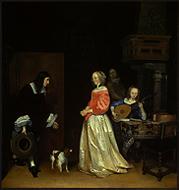Gerard Ter Borch or Terburg was born in Zwolle in 1617 and was first a pupil of his father before the latter sent him to Haarlem as an aide to Pieter Molyn with whom he worked between 1632 and 1635. After a short stay in England, Ter Borch went to Italy and returned in Amsterdam around 1641. He became rapidly successful as a portrait painter showing some mastery in rendering the looks of his sitters.

In 1646 he went to Munster where he stayed during two years while the Ambassador of Spain became his patron. Ter Borch went to Spain with him and he received a warm welcome from the Spanish court in Madrid.
Ter Borch returned to Holland via France around 1650 and settled in Deventer when he married a cousin. After becoming the burgomaster of that city he lived in opulence during some twenty years.
Gaspar Netscher and Roelof Koets were among his pupils and his first paintings related to popular representations of his time, such as military scenes and card players.
He soon found his way in the representation of bourgeois scenes showing women sewing, reading or writing or mothers with their children.
His interiror scenes were reminiscent of those produced by Vermeer, his contemporary, not only in painting intimate themes of the Dutch high society's life but also in showing sober interiors.
Contrary to Vermeer who was at ease with the rendering of light effects on the faces of his sitters, Ter Borch did not insist much on the importance of such detail in his paintings. Refinement and elegance seemed to interest him above all while the effects of light were concentrated on silk dresses or other fabrics.
Ter Borch seemed to underline the influence of Velasquez in certain of his portraits, notably in that of Helena van der Schalcke as a child, painted in 1641 with the interplay of silvered grey tones and the vibration of light effects on the little girl.
Ter Borch was in fact like a photographer giving much life and reality to his scenes always painted with minute accuracy. He however lacked the genius of Vermeer when it came to instill some intimate and warm atmosphere in his works in that sense that his paintings have a rather sweetmeat and sugary touch.
Ter Borch died in Deventer in 1681. His works, usually small formats, are rated between US $ 75,000 and 500,000